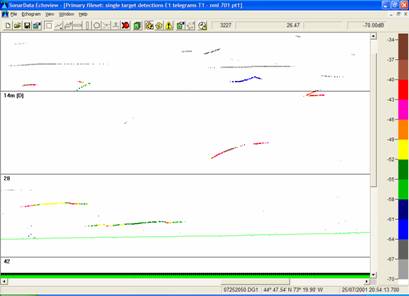Areal survey
Surveys may include both systematic and adaptive components. The systematic survey is generally the primary effort in an acoustic assessment. This term refers to the area-wide vessel survey that follows predetermined transects. Conversely, the purpose of an adaptive survey is to increase sampling effort when a region of high density is detected on systematic transects (Conners and Schwager 2002). Adaptive transects are performed at a higher resolution than systematic ones and aim to characterize the full extent of an observed aggregation. This information may be used in density/abundance estimates (Conners and Schwager 2002) or to gain insight on the spatial attributes of fish aggregations.
Stationary sounding
Elongated single fish tracks, representing multiple detections of the same fish, result from stationary observation (Fig. 11). These tracks may be used to gain insight on average TS, orientation, and movement that are not possible during systematic surveys.

Figure 11. Image of single rainbow smelt traces from stationary sounding.
Trawling
Trawl collections serve multiple purposes during an acoustic survey. They may be performed to:
identify the constituents of observed target assemblage types;
partition backscatter into species or age-group composition;
collect specimens for TS versus length estimates, or;
collect specimens for auxiliary information (e.g., age, diet, maturity, or sex)
Trawling may represent a significant amount of time during a survey, depending on deployment, fishing, and retrieval strategies. It is essential that trawl time be considered during the survey design phase.
At this time, no strict recommendations have been developed on the optimal number of trawls to be collected to access information auxiliary to the acoustic data. If variance in trawl and acoustic surveys are known, Simmonds and MacLennan (2005) provide recommendations on balancing trawling and survey components to minimize variance. Adams et al. (2006) propose a method for stratification of trawl and acoustic samples in Great Lakes surveys.
Environmental data
Temperature is required for the calculation of sound speed (c, m•s-1) and the acoustic absorption coefficient (a, dB•km-1). As temperature may vary across the survey area, measurements should be taken regularly. Consideration should be given to how environmental data will be used in analyses (e.g., correlation with density distribution), as a greater number of samples may be needed to meet this objective.
Supplementary information
Supplementary information, collected during stationary sounding, trawling, or environmental data collection may include:
specimen collection for diet or age analyses or fecundity;
single fish target tracking during stationary sounding, or;
abiotic data such as depth, temperature, thermocline depth, nutrients, or water clarity.
Taking time to observe/collect these things may reduce time available to acoustic sampling, so it is important to acknowledge costs and benefits of auxiliary information at the same time that survey design is being considered.
There are no simple formulae for weighting effort between collecting auxiliary information (e.g., age-composition) and collecting the acoustic samples themselves. But, the same considerations made for acoustic sampling (e.g., stratifying the collection of auxiliary information, increasing sampling of auxiliary information to increase precision) should be used when determining how auxiliary information should be collected.